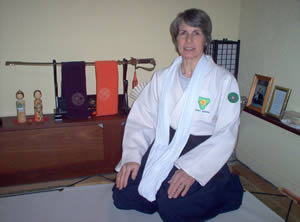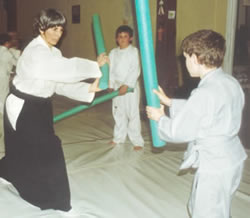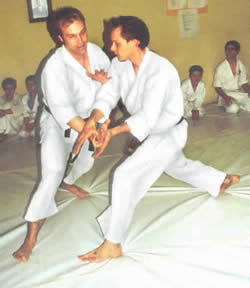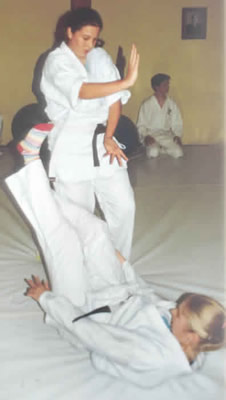The History of Aikido
By Sensei Hanifa Macfarlane
Aikido's path to this point has been a long one. Aiki-do arose
from the rich martial heritage of Japan. It is a form derived from
Jujutsu or soft/flexible art for both unarmed and armed combat.
"The inception of Jujutsu is recorded in the Kojiki [Record
of Ancient Matters] and the Nihon Shoki [Chronicles of Japan] compiled
at the beginning of the eighth century".
"…in most of the Martial Arts of Japan there are certain
elements worth being handed down … among any people, at any
time. … Every move is the outcome of the experience and contemplation
of ancient masters. In them is naturally fused, unified and embodied
the Oriental spirit as seen in Confucianism, Buddhism and the Teachings
of Lao-tse and Chuang-tse.
The Eightfold Path of Buddhism: Right belief, resolve, speech,
behaviour, occupation, effort, contemplation, and concentration.
'Tao invariably takes no action and yet there is nothing left undone'
Lao Tsu
On hearing of the Way the best of men will earnestly explore its
length.
The mediocre person learns of it and takes it up and sets it down.
But vulgar people when they hear the news will laugh out loud.
And if they did not laugh it would not be the Way.
'The superior man seeks the Way and not a mere living.' Confucius
'Carefully guard [the Tao] and do not lose it - this is what we
call "going back to the Real". Chuang Tsu
Aiki had its beginnings in 11th century Japan when General Yoshimitzu
Minamoto, a soldier, poet and physician taught the form to his
fighting men for their inner strength and development.
"According to the Den-Sho [manuscripts of instruction and
records of the secrets of the martial arts], the aiki jujitsu
dates as far back as the Kamakura period [1185-1336]. It was founded
by Yoshimitsu Minamoto [d. 1120] and handed down in the Minamoto
family for generations, and then was taken over by the Takeda
family of the Aizu clan. After seven generations the legitimate
inheritor of the art is Moritaka Ueyshiba."
'The Aizu clan was a stronghold of Chu Hsi [Neo Confucian] doctrine.
These teachings were known as aiki-in-yo-ho, or "the doctrine
of harmony of spirit based on yin-yang." The Aizu warriors
were all educated in the Chu Hsi ethic. Their interpretation of
Bushido was a strict code embodying Chu Hsi concepts. The concept
of ki, which is the essence of all aiki-do is not without antecedent
in the Chu Hsi dualism, where it is described as a "material
force" in connection with its complement, ri, or "principle."
Ki is also explained by the Neo Confucian Kaibara Ekken, who qualified
the dualisms of Chu Hsi and viewed ki as a monism.'
The original Aiki was a fighting art as in Aikijutsu. The 'Do'
or 'Way' form arose from the school developed by Uyeshiba Sensei
and it has spread widely in the West. His five main inheritors
have further developed Aikido and it has diversified into their
various schools. "More than thirty different sects of aiki-do
exist today" [In Japan]. Some are Aiki-jutsu or 'art ' forms
from the early forms, some Aiki-do, or spiritual path forms.
The first school of Ai-ki to develop Aikido as a sport was founded
by the late Professor Kenji Tomiki. He was professor of Physical
Education at Tokyo's Waseda University, a master of Judo and Aikido
and a direct student of both Master Jigoro Kano who founded Judo
and Uyeshiba Sensei.
His style, which he called Aikido Kyogi or Sports Aikido was established
under the auspices of the Waseda University Sports Department.
Tomiki Sensei utilized the grading structure and fundamental principles
of Judo as developed by Kano Sensei. He rationalized the Aikido
forms of Uyeshiba Sensei so they could be more efficiently taught
in schools and universities.
Tomiki Sensei spread his style throughout Japan particularly in
universities with Aikido sport competitions gaining in popularity.
His Aikido spread internationally to Europe, the U.K. North and
South America, South East Asia, and Australia through his own
visits to the U.S. in 1953 and Australia in 1977and via his senior
students. International competitions and demonstrations are held
bi-annually. At the first international competition held in Australia
in 1999, Sensei Hanifa of Unity Aikido gave the keynote speech
as the founder of the first Tomiki style Aikido organization in
Australia.

 Almiraj Sufi & Islamic Study Centre, Inc.
Almiraj Sufi & Islamic Study Centre, Inc.








